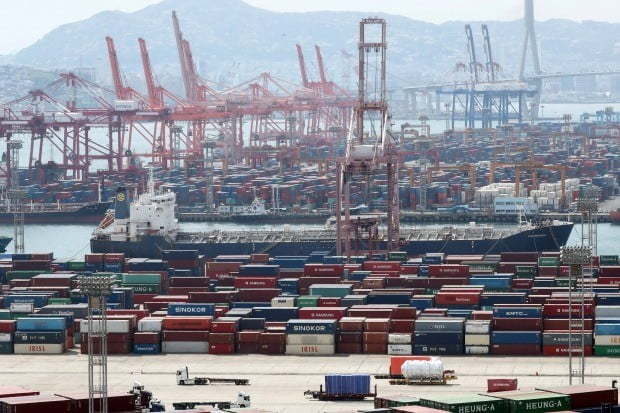 |
(Yonhap) |
South Korea's economy contracted at a sharper rate than what had been expected in the second quarter, delivering the worst performance in over two decades, as the pandemic hammered outbound shipments and private spending in Asia's fourth-largest economy, central bank data showed Thursday.
In the April-June period, the country's real gross domestic product (GDP) shrank 2.9 percent from the same period last year, marking the slowest growth since a 3.8 percent on-year contraction in the last three months of 1998, according to advance data from the Bank of Korea (BOK).
From three months earlier, the local economy also contracted 3.3 percent, the slowest on-quarter growth since the first quarter of 1998, when it contracted 6.8 percent.
In the first quarter, the South Korean economy declined 1.3 percent on-quarter. However, on a on-year basis, the economy expanded 1.4 percent in the January-March period.
The BOK earlier anticipated the economy to shrink about 2 percent on-year in the April-June period, placing its annual growth outlook at a contraction of 0.2 percent.
"This was largely caused by a sharp drop in exports with the new coronavirus continuing to spread, unlike our expectation that it will likely slow down," said Park Yang-su, head of BOK's economic statistics office.
"Exports fell sharply, partly due to economic lockdowns in major import countries," he told a press briefing.
But BOK Gov. Lee Ju-yeol last week noted the South Korean economy will likely suffer a heavier than earlier anticipated blow this year due to the COVID-19 pandemic.
"When we offered our growth projection in May, we had expected the COVID-19 pandemic to begin slowing down in the second half of the year, but now we are in the second week of July, and the spread of the disease is rather accelerating," he told a press briefing last Thursday.
"And therefore, the recovery in our exports may further be delayed, in which case our economic growth cannot but also be affected," he said.
In its May projection, the BOK predicted the local economy to contract by as much as 1.8 percent on-year in 2020 under what it then called the worst possible scenario, highlighted by a global resurgence in COVID-19 infections.
South Korea's exports plunged 13.6 percent on-year in the second quarter, marking a turnaround from a 5.6 percent on-year increase in the first three months of the year.
It also marks the sharpest on-year decline in exports since the fourth quarter of 1974, when outbound shipments dropped 17.9 percent.
Park said South Korea's economic growth will largely depend on the future course of the COVID-19 pandemic and on the degree of economic lockdowns in other countries that will set the course of its exports.
"The country's annual economic growth will be determined by whether other countries will not strengthen their lockdowns even if the COVID-19 pandemic does not slow, and by their efforts to boost economic growth," the BOK official said.
Domestic consumption continued to remain weak in the second quarter, slipping 4.1 percent on-year, which marks a slight improvement from a 4.8 percent on-year contraction in the first quarter.
To help boost local spending, the central bank has so far delivered two rate reductions, slashing the policy rate by 75 basis points to a record low of 0.5 percent.
The country's consumer prices, however, have been weakening, posting negative 0.3 percent on-year growth in May that apparently reflected slow demand at home.
Consumer prices remained unchanged from a year earlier in June.
Government spending again helped keep the local economy stay afloat, adding 6 percent from a year earlier in the second quarter.
The government has so far boosted its budget spending by at least 59 trillion won ($49.3 billion) with three batches of supplementary budgets to boost the virus-hit economy. The country reported its first COVID-19 case on Jan. 20.
Its third and latest extra budget secured an additional 35.1 trillion won in spending, marking the largest-ever single supplementary budget in the country's history.
Despite massive budget spending, private investment continued to remain sluggish, with construction investment growing only 0.1 percent on-year in the second quarter, sharply slowing from a 4.2 percent on-year expansion in the January-March period.
Construction investment gained 1.5 percent on-year, also slowing from a 7.5 percent expansion in the first quarter, according to the BOK.
By sector, output by the manufacturing industry plunged 6.7 percent on-year, a turnaround from a 3.5 percent on-year increase in the first quarter.
Output by the construction sector dipped 0.2 percent, compared with a 3 percent on-year gain in the first quarter, while that of the service sector slipped 1.7 percent, also marking a turnaround from 0.2 percent growth in the previous quarter.
Park refused to offer a growth estimate for the whole year when asked, but insisted a slower-than-expected growth in the second quarter will not necessarily mean an equally large drop in the annual growth rate.
On-quarter growth of 3 percent or higher in the remainder of the year would still put the country's annual growth at negative 0.2 percent, he noted.
The BOK is set to offer a revised growth outlook for the year on Aug. 27. (Yonhap)






![[Herald Interview] 'Trump will use tariffs as first line of defense for American manufacturing'](http://res.heraldm.com/phpwas/restmb_idxmake.php?idx=644&simg=/content/image/2024/11/26/20241126050017_0.jpg)
![[Exclusive] Hyundai Mobis eyes closer ties with BYD](http://res.heraldm.com/phpwas/restmb_idxmake.php?idx=644&simg=/content/image/2024/11/25/20241125050044_0.jpg)
